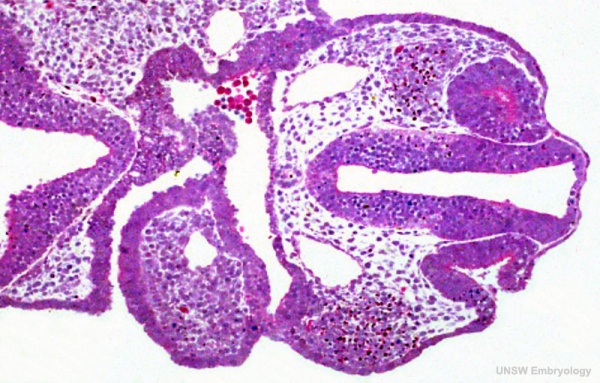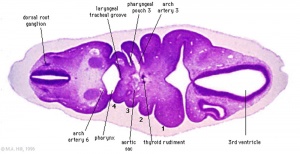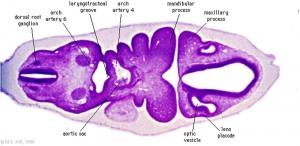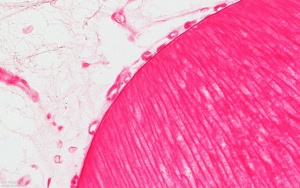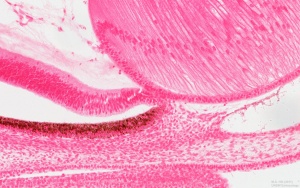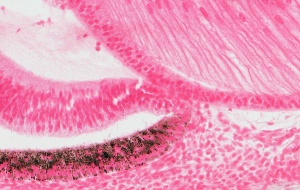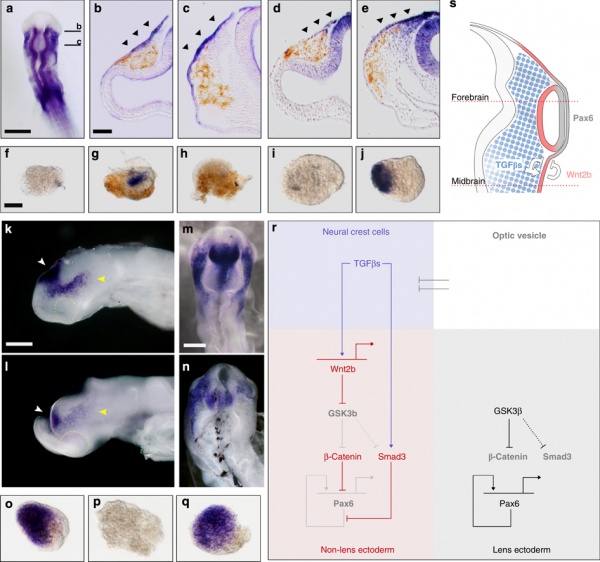Vision - Lens Development: Difference between revisions
(→Week 4) |
(→Week 4) |
||
| Line 20: | Line 20: | ||
==Week 4== | ==Week 4== | ||
[[File:Stage11_sem8.jpg|thumb|Human Embryo [[Carnegie stage 11]]]] | [[File:Stage11_sem8.jpg|thumb|Human Embryo [[Carnegie stage 11]]]] | ||
[[File:Stage12 sem6.jpg|thumb|Human Embryo [[Carnegie stage 12]]]] | |||
[[File:Stage11_histology-optic_pit.jpg|600px]] | [[File:Stage11_histology-optic_pit.jpg|600px]] | ||
Revision as of 11:29, 7 September 2011
Introduction
The lens or crystalline lens or aquula (Latin, aquula = a little stream) has a key role in focussing light (with the cornea) upon the neural retina. The lens embryonic origin is from surface ectoderm of the sensory placodes that form in the head region (More? Week 4 - Placodes). The lens focusses by refracting light as it passes through the biconvex lens, which can be altered in shape (accommodation) by surrounding ciliary muscles. These ciliary muscles are activated (contracted) by parasympathetic innervation from the ciliary ganglion itself innervated by the oculomotor nerve (Cranial Nerve III) (More? Cranial Nerves).
| Placodes
Some Recent Findings
|
Development Overview
surface ectoderm -> lens placode -> lens pit -> lens vesicle -> lens fibres -> lens capsule and embryonic/fetal nucleus.
Week 4


Human Embryo Carnegie stage 11 optic pit
Week 5
Week 8
Human embryo Carnegie stage 22
Molecular Signaling
Wnt mediates lens repression by neural crest cells and Transforming growth factor-β[3] (open image for full description)
- Links: Lens Development | Neural Crest Development | Wnt | Lens repression by neural crest cells | Proposed model how NCCs organize the eye | molecular model to explain TGF-β- and Wnt-mediated lens restriction
References
- ↑ <pubmed>20171212</pubmed>
- ↑ <pubmed>20105280</pubmed>
- ↑ Grocott T, Johnson S, Bailey AP, Streit A. Neural crest cells organize the eye via TGF-β and canonical Wnt signalling. Nat Commun. 2011 Apr;2:265. PMID21468017 | Nat Commun.
Glossary Links
- Glossary: A | B | C | D | E | F | G | H | I | J | K | L | M | N | O | P | Q | R | S | T | U | V | W | X | Y | Z | Numbers | Symbols | Term Link
Cite this page: Hill, M.A. (2024, June 26) Embryology Vision - Lens Development. Retrieved from https://embryology.med.unsw.edu.au/embryology/index.php/Vision_-_Lens_Development
- © Dr Mark Hill 2024, UNSW Embryology ISBN: 978 0 7334 2609 4 - UNSW CRICOS Provider Code No. 00098G

